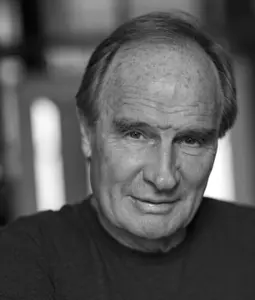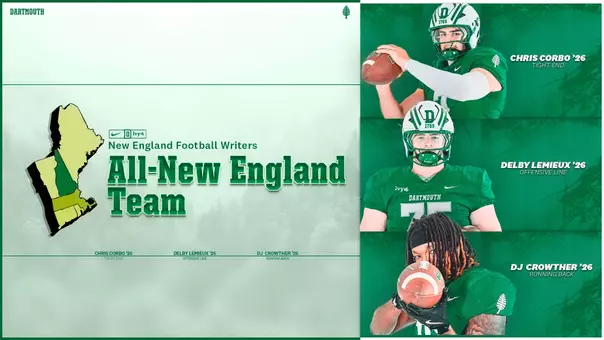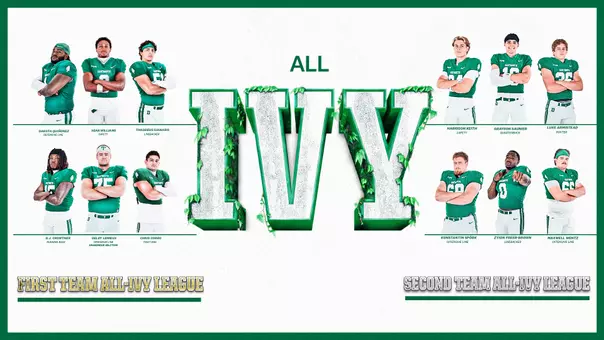
A Snapshot in Time
11/6/2007 12:00:00 AM | Football, Athletics
A Snapshot in Time
By Jack DeGange
More than ever before in this age of digital images anyone can point a camera and take a picture.
But, capturing the defining instant that portrays the emotion and athletic excellence of a competitive moment in the world of sports, when an image requires no descriptive caption and is remembered for decades, requires rare talent, planning and foresight and, even then, occasional good luck.
Welcome to the world of Heinz Kluetmeier '65 whose career as a photojournalist for Sports Illustrated spans nearly four decades and was recognized in mid-October when he received the prestigious Lucie Award for outstanding achievement in sports photography.
In an interview with the Columbia Journalism Review, Kluetmeier said, “Ninety percent of every (sports) photograph is given to getting to the shooting locations, getting into position. You find these people, who have great control over their bodies, in a graceful and poetic moment while seriously competing.”
Kluetmeier asked Lynn Swann, the former wide receiver for the Pittsburgh Steelers, to be his presenter at the Lucie Awards on October 15. “It was my opportunity to honor someone, a perfect athlete, in return,” said Kluetmeier. “Without athletes like Lynn, this prize wouldn't have happened for me. Lynn represents many great athletes who are genetically blessed and have the personal qualities we all come to admire.“
It was during Super Bowl X in 1976 that Kluetmeier captured Swann's lofty catch of the pass from quarterback Terry Bradshaw, a 64-yard play that was the decisive touchdown in Pittsburgh's 21-17 win over the Dallas Cowboys.
Swann was the most valuable player in that Super Bowl game and the picture became one of more than 100 by Kluetmeier that have adorned the cover of Sports Illustrated over the years. “It seemed like Lynn hung in the air forever to make the catch,” said Kluetmeier. “It was like he was saying to me, ?Have you got it yet? Have you got it yet?'”
Born in Berlin, Germany during World War II, Kluetmeier's family arrived in Milwaukee, Wis., in 1952 when Heinz was nine years old. The only English words he knew were “yes,” “no” and “thank you.”
His career as a professional photographer began as a freelancer for The Associated Press while he was a student at Custer High School in Milwaukee, covering the Green Bay Packers and the 1960 presidential campaign. He was offered a journalism scholarship to Northwestern University but came to Dartmouth in 1961.
“I don't think I chose Dartmouth,” he said. “I think Dartmouth chose me. The two alums that interviewed me (at Custer High) were fervent and passionate about Dartmouth. They convinced me.”
Kluetmeier became an engineering major (“My father never believed that photography would develop into a career.”) and continued his work as a photographer, covering Dartmouth athletics and events at Hopkins Center, which opened during his sophomore year. Adrian Bouchard, the college photographer for many years, gave Kluetmeier use of his darkroom in College Hall (now Collis) while he was a freelancer for The Associated Press's Boston bureau.
His summer freelance work in Milwaukee continued through his Dartmouth days and he put the engineering degree to work for a couple of years with Inland Steel. He worked for the Milwaukee Journal for a year-and-a-half and then, in 1969, joined the staff of Time, Inc., working for both Life Magazine and Sports Illustrated until Life's demise in 1973. He's been a member of the SI staff ever since including two stints as director of photography. Today he is SI's senior staff photographer.
Among Dartmouth alumni who have made their career in photography, Kluetmeier and James Nachtwey '71 are most prominent though, Kluetmeier said, “We're just more visible because of our magazine work.” Nachtwey's career in covering wars and civil strife around the world since the early 1980s earned him the Lucie Award in 2004. “James is truly a mensch. He covers difficult subjects with such great sensitivity,” said Kluetmeier. “I admire him and his work tremendously. He covers subjects I've always found very difficult to photograph though I would do so on assignment if it made a difference to what happens in the world.
“Photojournalism and sports photography are the same thing except that (for me) the photojournalistic subject happens to be sports,” he noted. “Photojournalism is telling a story. It's taking pictures of something as it evolves without controlling it, without being anything but being there and looking at it through your point of view.”
That point of view measures Kluetmeier's creativity as he covers sports around the world for SI. His setups for events like the Super Bowl, the Olympics and the Kentucky Derby involve hours, even days, of planning and site selection for remote cameras, a constant pursuit of the location that will produce a great photograph that, he said, “...defines a moment in the world, in an event and in life that people go back to again and again. It's a picture that everyone can relate to on a personal level.”
As he said of his view through rain and mud of the homestretch during the 2004 Kentucky Derby, “You hope the remotes run and all the cameras (he has 15-20 positioned strategically) are protected and work.”
Or, the staged picture of Olympic swimmer Michael Phelps working with a computer at the bottom of the University of Michigan pool. Kluetmeier donning scuba gear to capture Phelps (who held his breath for nearly two minutes). For another underwater picture of Phelps during the 2004 Olympic Trials at Long Beach, Calif., he placed his cameras hours before the event. “You have to do your homework,” he said. As it turned out, Phelps and the camera were in the same lane.
Kluetmeier's assignments have him on the road more than 200 days a year. The day after receiving the Lucie Award he was off to Houston, then Milwaukee, to photograph NBA stars Yao Ming, the Rockets's 7-6 center, and the Bucks's 7-0 center, Yi Jianlian for SI's China edition. Last weekend he covered the Redskins-Patriots game in Foxborough, Mass.
Kluetmeier has homes in New York City and Florida. For the past 15-20 years he “runs away for a couple of weeks of vacation” to photograph the performers in the Ringling Brothers and Barnum & Bailey Circus.
He's covered every Olympiad since Munich in 1972 when he went from covering sports to covering tragedy as 11 Israeli athletes and coaches were murdered by Palestinian terrorists.
Contrasting that tragic event, one of Kluetmeier's best known images is his vibrant photo of the celebration by the U.S. hockey team after its gold medal victory over Finland (the heavily favored Soviet Union was beaten in the semifinals) during the 1980 Winter Games at Lake Placid.
“There are some pictures that you're remembered for,” he said. “I think that's one of the pictures that people remember that I've taken. It's the moment that is compelling. It was the first time that Sports Illustrated ever ran a cover without a billing to identify what was happening ? because everybody knew.
“I'm a cynic by nature but that week I believed in miracles.”
His job is to take pictures and stay out of harm's way. He's had his share of close calls on the sidelines at football games but found himself in the middle of the action during Game Six of the 1975 World Series at Fenway Park when Carlton Fisk hit his historic home run to beat the Cincinnati Reds.
“When Carlton hit that home run, the place went crazy,” he recalled. “Normally you try to stay back and photograph the event and not run out there because you lose things. Fans were climbing over my back, trying to get on the field. I was swept out there and when Carlton jumped on the plate he actually jumped on my foot. I realized where I was when I looked at a local paper the next morning with an overhead shot. I was right there at the plate, almost greeting him with my camera.”
Jack DeGange, a freelance writer, was sports information director at Dartmouth from 1968-77.
By Jack DeGange
More than ever before in this age of digital images anyone can point a camera and take a picture.
But, capturing the defining instant that portrays the emotion and athletic excellence of a competitive moment in the world of sports, when an image requires no descriptive caption and is remembered for decades, requires rare talent, planning and foresight and, even then, occasional good luck.
Welcome to the world of Heinz Kluetmeier '65 whose career as a photojournalist for Sports Illustrated spans nearly four decades and was recognized in mid-October when he received the prestigious Lucie Award for outstanding achievement in sports photography.
In an interview with the Columbia Journalism Review, Kluetmeier said, “Ninety percent of every (sports) photograph is given to getting to the shooting locations, getting into position. You find these people, who have great control over their bodies, in a graceful and poetic moment while seriously competing.”
Kluetmeier asked Lynn Swann, the former wide receiver for the Pittsburgh Steelers, to be his presenter at the Lucie Awards on October 15. “It was my opportunity to honor someone, a perfect athlete, in return,” said Kluetmeier. “Without athletes like Lynn, this prize wouldn't have happened for me. Lynn represents many great athletes who are genetically blessed and have the personal qualities we all come to admire.“
It was during Super Bowl X in 1976 that Kluetmeier captured Swann's lofty catch of the pass from quarterback Terry Bradshaw, a 64-yard play that was the decisive touchdown in Pittsburgh's 21-17 win over the Dallas Cowboys.
Swann was the most valuable player in that Super Bowl game and the picture became one of more than 100 by Kluetmeier that have adorned the cover of Sports Illustrated over the years. “It seemed like Lynn hung in the air forever to make the catch,” said Kluetmeier. “It was like he was saying to me, ?Have you got it yet? Have you got it yet?'”
Born in Berlin, Germany during World War II, Kluetmeier's family arrived in Milwaukee, Wis., in 1952 when Heinz was nine years old. The only English words he knew were “yes,” “no” and “thank you.”
His career as a professional photographer began as a freelancer for The Associated Press while he was a student at Custer High School in Milwaukee, covering the Green Bay Packers and the 1960 presidential campaign. He was offered a journalism scholarship to Northwestern University but came to Dartmouth in 1961.
“I don't think I chose Dartmouth,” he said. “I think Dartmouth chose me. The two alums that interviewed me (at Custer High) were fervent and passionate about Dartmouth. They convinced me.”
Kluetmeier became an engineering major (“My father never believed that photography would develop into a career.”) and continued his work as a photographer, covering Dartmouth athletics and events at Hopkins Center, which opened during his sophomore year. Adrian Bouchard, the college photographer for many years, gave Kluetmeier use of his darkroom in College Hall (now Collis) while he was a freelancer for The Associated Press's Boston bureau.
His summer freelance work in Milwaukee continued through his Dartmouth days and he put the engineering degree to work for a couple of years with Inland Steel. He worked for the Milwaukee Journal for a year-and-a-half and then, in 1969, joined the staff of Time, Inc., working for both Life Magazine and Sports Illustrated until Life's demise in 1973. He's been a member of the SI staff ever since including two stints as director of photography. Today he is SI's senior staff photographer.
Among Dartmouth alumni who have made their career in photography, Kluetmeier and James Nachtwey '71 are most prominent though, Kluetmeier said, “We're just more visible because of our magazine work.” Nachtwey's career in covering wars and civil strife around the world since the early 1980s earned him the Lucie Award in 2004. “James is truly a mensch. He covers difficult subjects with such great sensitivity,” said Kluetmeier. “I admire him and his work tremendously. He covers subjects I've always found very difficult to photograph though I would do so on assignment if it made a difference to what happens in the world.
“Photojournalism and sports photography are the same thing except that (for me) the photojournalistic subject happens to be sports,” he noted. “Photojournalism is telling a story. It's taking pictures of something as it evolves without controlling it, without being anything but being there and looking at it through your point of view.”
That point of view measures Kluetmeier's creativity as he covers sports around the world for SI. His setups for events like the Super Bowl, the Olympics and the Kentucky Derby involve hours, even days, of planning and site selection for remote cameras, a constant pursuit of the location that will produce a great photograph that, he said, “...defines a moment in the world, in an event and in life that people go back to again and again. It's a picture that everyone can relate to on a personal level.”
As he said of his view through rain and mud of the homestretch during the 2004 Kentucky Derby, “You hope the remotes run and all the cameras (he has 15-20 positioned strategically) are protected and work.”
Or, the staged picture of Olympic swimmer Michael Phelps working with a computer at the bottom of the University of Michigan pool. Kluetmeier donning scuba gear to capture Phelps (who held his breath for nearly two minutes). For another underwater picture of Phelps during the 2004 Olympic Trials at Long Beach, Calif., he placed his cameras hours before the event. “You have to do your homework,” he said. As it turned out, Phelps and the camera were in the same lane.
Kluetmeier's assignments have him on the road more than 200 days a year. The day after receiving the Lucie Award he was off to Houston, then Milwaukee, to photograph NBA stars Yao Ming, the Rockets's 7-6 center, and the Bucks's 7-0 center, Yi Jianlian for SI's China edition. Last weekend he covered the Redskins-Patriots game in Foxborough, Mass.
Kluetmeier has homes in New York City and Florida. For the past 15-20 years he “runs away for a couple of weeks of vacation” to photograph the performers in the Ringling Brothers and Barnum & Bailey Circus.
He's covered every Olympiad since Munich in 1972 when he went from covering sports to covering tragedy as 11 Israeli athletes and coaches were murdered by Palestinian terrorists.
 One of Heinz Kluetmeier's most memorable photos: “Do you believe in miracles?”celebration at USA Hockey's gold medal 1980 Winter Olympics. It was the first time Sports Illustrated ran a cover photo without a descriptive caption. |
Contrasting that tragic event, one of Kluetmeier's best known images is his vibrant photo of the celebration by the U.S. hockey team after its gold medal victory over Finland (the heavily favored Soviet Union was beaten in the semifinals) during the 1980 Winter Games at Lake Placid.
“There are some pictures that you're remembered for,” he said. “I think that's one of the pictures that people remember that I've taken. It's the moment that is compelling. It was the first time that Sports Illustrated ever ran a cover without a billing to identify what was happening ? because everybody knew.
“I'm a cynic by nature but that week I believed in miracles.”
His job is to take pictures and stay out of harm's way. He's had his share of close calls on the sidelines at football games but found himself in the middle of the action during Game Six of the 1975 World Series at Fenway Park when Carlton Fisk hit his historic home run to beat the Cincinnati Reds.
“When Carlton hit that home run, the place went crazy,” he recalled. “Normally you try to stay back and photograph the event and not run out there because you lose things. Fans were climbing over my back, trying to get on the field. I was swept out there and when Carlton jumped on the plate he actually jumped on my foot. I realized where I was when I looked at a local paper the next morning with an overhead shot. I was right there at the plate, almost greeting him with my camera.”
Jack DeGange, a freelance writer, was sports information director at Dartmouth from 1968-77.
Women's Basketball vs. Bucknell Postgame Press Conference 12-7-25
Sunday, December 07
Dartmouth Men's Hockey Highlights vs Yale, 12.6.25
Sunday, December 07
MBB at Wyoming Postgame Interview 12/6/25
Sunday, December 07
Dartmouth Men's Hockey Media Availability vs Yale 12.6.25
Sunday, December 07








